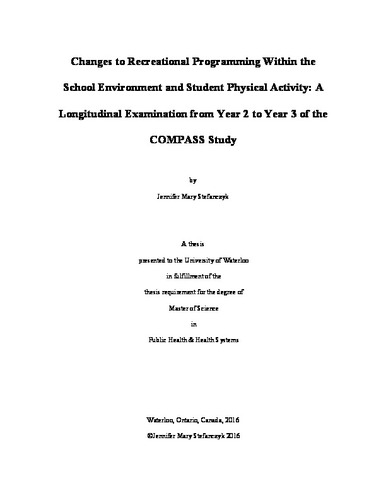| dc.contributor.author | Stefanczyk, Jennifer | |
| dc.date.accessioned | 2016-05-16 13:26:51 (GMT) | |
| dc.date.available | 2016-05-16 13:26:51 (GMT) | |
| dc.date.issued | 2016-05-16 | |
| dc.date.submitted | 2016 | |
| dc.identifier.uri | http://hdl.handle.net/10012/10477 | |
| dc.description.abstract | Objective: This study examined the influence of changes to school recreational programming on the prevalence and likelihood of Ontario and Alberta secondary school students meeting the (i) Canadian Society for Exercise Physiology (CSEP) physical activity guideline and (ii) ≥60 minutes of daily moderate to vigorous physical activity (MVPA).
Methods: Student- and school-level data was obtained using Year 2 and Year 3 COMPASS data. This longitudinal analysis assessed how changes to school recreational programming (including the addition, modification or removal of intramurals/non-competitive clubs) within 20 intervention schools influenced student physical activity (PA) levels compared to students who attended a school that made no PA practice changes (True Control Schools; n=43) or made other PA practice changes unrelated to school recreational programming (Other Practice Intervention (OPI) Schools; n=23). PA was measured using two outcome variables: achieving the CSEP guideline and achieving ≥60 minutes of daily MVPA. Descriptive statistics, ANOVA and hierarchical longitudinal analysis were conducted with relevant covariates controlled for within the models.
Results: Significant differences were found in the prevalence of students meeting (i) the CSEP guideline, and (ii) ≥60 minutes of daily MVPA between Year 2 and Year 3 of the COMPASS study. In Year 2, 31.0% of students met the CSEP guideline and 47.8% achieved ≥60 minutes of daily MVPA. In Year 3, 28.5% of students met the CSEP guideline and 52.2% achieved ≥60 minutes of daily MVPA. There were no significant differences in the school-level prevalence of a student meeting the (i) CSEP or (ii) MVPA guideline in intervention schools as compared to control schools respectively. Students that attended School 9 were significantly less likely to meet the CSEP guideline after modifications were made to their school recreational programming in comparison to students who attended true control (RR=0.74) and OPI (RR=0.73) schools. Moreover, students that attended School 15 were significantly less likely to achieve ≥60 minutes of daily MVPA after modifications were made to their school recreational programming in comparison to students that attended true control (RR=0.71) and OPI (RR=0.71) schools. Students who are male, have weekly spending money of $21-100 or greater than $100, have 1-4 or greater than 5 active friends, are enrolled in physical education, participate in varsity sports or community sports were significantly more likely to meet the CSEP and MVPA guideline. Furthermore, students who began participating in school recreational programming in Year 3 and students who participated in both Year 2 and Year 3 had a significant increase in likelihood of obtaining (i) the CSEP guideline and (ii) ≥60 minutes of daily MVPA compared to students who did not participate in either year.
Conclusion: Current school-based PA programming appears insufficient, as the majority of youth in the COMPASS study are not achieving the recommended amount of PA suggested in the Canadian PA guidelines. This study identified 20 school recreational programming interventions between Year 2 and Year 3 of the COMPASS study. Only two of the interventions were statistically significant, however they did not have the desired effect on student PA. Three school recreational programming interventions that appear promising for future school-based PA research are also discussed. Future research should explore how to improve and tailor specific school recreational options within different contextual settings and with populations at greater risk of inactivity. | en |
| dc.language.iso | en | en |
| dc.publisher | University of Waterloo | en |
| dc.title | Changes to Recreational Programming Within the School Environment and Student Physical Activity: A Longitudinal Examination from Year 2 to Year 3 of the COMPASS Study | en |
| dc.type | Master Thesis | en |
| dc.pending | false | |
| uws-etd.degree.department | School of Public Health and Health Systems | en |
| uws-etd.degree.discipline | Health Studies and Gerontology | en |
| uws-etd.degree.grantor | University of Waterloo | en |
| uws-etd.degree | Master of Science | en |
| uws.contributor.advisor | Leatherdale, Scott | |
| uws.contributor.affiliation1 | Faculty of Applied Health Sciences | en |
| uws.published.city | Waterloo | en |
| uws.published.country | Canada | en |
| uws.published.province | Ontario | en |
| uws.typeOfResource | Text | en |
| uws.peerReviewStatus | Unreviewed | en |
| uws.scholarLevel | Graduate | en |

